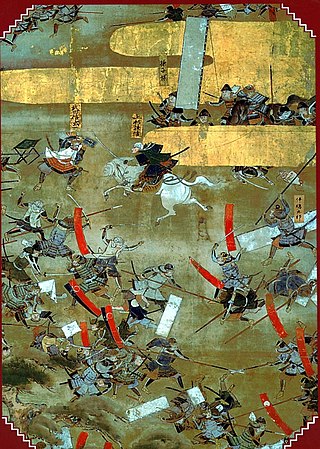
The Sengoku period is the period in Japanese history in which civil wars and social upheavals took place almost continuously in the 15th and 16th centuries. Though the Ōnin War (1467) is generally chosen as the Sengoku period's start date, there are many competing historiographies for its end date, ranging from 1568, the date of Oda Nobunaga's march on Kyoto, to the suppression of the Shimabara Rebellion in 1638, deep into what is traditionally considered the Edo period. Regardless of the dates chosen, the Sengoku period overlaps substantially with the Muromachi period (1336–1573).
Satomi is a feminine Japanese given name which is also used as a surname.

The Later Hōjō clan was one of the most powerful samurai families in Japan in the Sengoku period and held domains primarily in the Kantō region. Their last name was simply Hōjō (北条) but in order to differentiate between the earlier Hōjō clan with the same name and mon were called "Later Hōjō", although this was not the official family name.
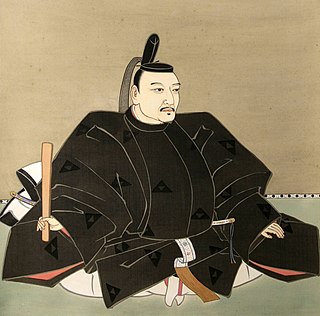
Hōjō Ujimasa was the fourth head of the later Hōjō clan, and daimyō of Odawara. Ujimasa succeeded the territory expansion policy from his father, Hojo Ujiyasu, and achieved the biggest territory in the clan's history.

Hōjō Ujiyasu was a daimyō (warlord) and third head of the Odawara Hōjō clan. Known as the "Lion of Sagami", he was revered as a fearsome warrior and a cunning man. He is famous for his strategies of breaking the siege from Takeda Shingen and Uesugi Kenshin. A son of Hōjō Ujitsuna, his only known wife was Imagawa Yoshimoto's sister, Zuikei-in. Among his sons are Hōjō Ujimasa and Uesugi Kagetora.

The Satake clan was a Japanese samurai clan that claimed descent from the Minamoto clan. Its first power base was in Hitachi Province. The clan was subdued by Minamoto no Yoritomo in the late 12th century, but later entered Yoritomo's service as vassals. In the Muromachi period, the Satake served as Governor (shugo) of Hitachi Province, under the aegis of the Ashikaga shogunate. The clan sided with the Western Army during the Battle of Sekigahara, and was punished by Tokugawa Ieyasu, who moved it to a smaller territory in northern Dewa Province at the start of the Edo period. The Satake survived as lords (daimyō) of the Kubota Domain. Over the course of the Edo period, two major branches of the Satake clan were established, one ruled the fief of Iwasaki, the other one the fief of Kubota-Shinden.
Satomi Yoshihiro was a samurai of the Satomi family who fought against the Hōjō clan during Japan's Sengoku period.
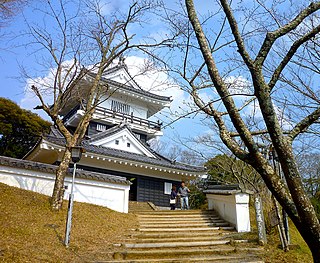
Kururi Castle is a Japanese castle located in Kimitsu, southern Chiba Prefecture, Japan. At the end of the Edo period, Kururi Castle was home to a branch of the Kuroda clan, daimyō of Kururi Domain. The castle was also known as Rain Castle, after a legend that it rained twenty-one times during its construction, or, on average, once every three days. It is located on a 227 meter hill.

Tateyama Domain was a feudal domain under the Tokugawa shogunate of Edo period Japan, located in Awa Province, Japan. It was centered on Tateyama Castle in what is now the city of Tateyama, Chiba.
Awa-Katsuyama Domain was a feudal domain under the Tokugawa shogunate of Edo period Japan, located in Awa Province, Japan. It was centered in what is now part of the city of Kamogawa, Chiba.

Kururi Domain was a feudal domain under the Tokugawa shogunate of Edo period Japan, located in Kazusa Province, Japan. It was centered on Kururi Castle in what is now the city of Kimitsu, Chiba.

Sanuki Domain was a feudal domain under the Tokugawa shogunate of Edo period Japan, located in Kazusa Province. It was centered on Sanuki Castle in what is now the city of Futtsu, Chiba.
Ichinomiya Domain was a feudal domain under the Tokugawa shogunate of Edo period Japan, located in Kazusa Province, Japan. It was centered on Ichinomiya jin'ya in what is now the town of Ichinomiya, Chiba.

Karasuyama Domain was a feudal domain under the Tokugawa shogunate of Edo period Japan, located in the Nasu region of northern Shimotsuke Province, Japan. It was centered on Karasuyama Castle in what is now part of the city of Karasuyama, Tochigi. Karasuyama was ruled by a number of clans in its early history, but was ruled by a junior branch of the Ōkubo clan from the mid-Edo period onwards. The Karasuyama Ōkubo clan maintained a secondary jin'ya in what is now Atsugi, Kanagawa to administer its extensive holdings in Sagami Province.

Iwatsuki Castle is a Japanese castle located in Iwatsuki-ku, Saitama, in Saitama Prefecture, Japan. At the end of the Edo period, Tateyama Castle was home to the Ōoka clan, daimyō of Iwatsuki Domain, however the castle dates from the Muromachi period and was inhabited by many samurai lords over its history. During the Edo period, the name of the castle was written as “岩付城”. It was also known as "White Crane Castle" or "Floating Castle". The site of the castle is a Saitama Prefectural Historic Monument.
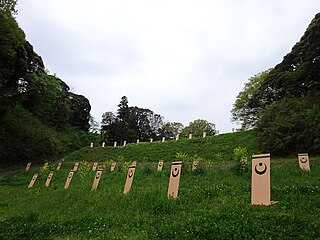
Moto Sakura Castle was a Muromachi period "hirayama"-style castle located on the border of the town of Shisui and the city of Sakura, Chiba Prefecture, Japan. Its ruins been protected as a National Historic Site since 1998.
Inamura Castle was a Muromachi period Japanese castle located in what is now the city of Tateyama, Chiba Prefecture, Japan. The ruins have been protected as a National Historic Site since 2012 together with Okamoto Castle as the Satomi clan castle ruins.
Okamoto Castle was a Muromachi period Japanese castle located in what is now the city of Minamibōsō, Chiba Prefecture, Japan. The ruins have been protected as a National Historic Site since 2012 together with Inamura Castle as the Satomi clan castle ruins.
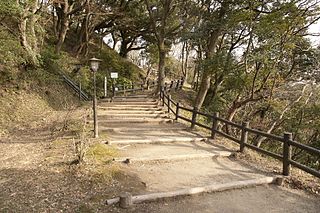
Satomi Yoshitaka was a Japanese samurai and head of the Satomi clan.














